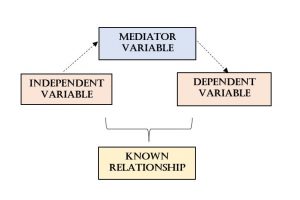Aim 1
Goal: To investigate how the Positive Action program achieves its effects, by testing the causal paths reflected in the logic/theoretic model for the Positive Action program that are expected to mediate effects of Positive Action on behavioral, emotional and academic outcomes.
As previous research has already demonstrated the positive impact of the program, Aim 1 will utilize mediation analyses to investigate how Positive Action achieves its effects.
A mediation model seeks to better understand a known relationship between an independent and dependent variable by introducing a third “mediator” variable, which may be found to mediate the relationship between the two, as depicted below.
According to Baron and Kenney (1986), “In general, a given variable may be said to function as a mediator to the extent that it accounts for the relation between the predictor and the criterion. Mediators explain how external physical events take on internal psychological significance. Whereas moderator variables specify when certain effects will hold, mediators speak to how or why such effects occur” (p. 1176).

Aim 1 will investigate potential mediator variables that may be influencing the impact of the program on student outcomes, thus helping to explain how Positive Action achieves its research-proven results.
Aim 1 Hypotheses:
(a) effects of Positive Action on student character/social development and supportive outcomes will be partially mediated by its effects on school and classroom climate
(b) effects of Positive Action on academic, behavioral, and emotional outcomes will be mediated most proximally by its effects on SECD and supportive outcomes.
Thus, the sub-aims are to:
Aim 1a: Test the hypothesis that changes in school and classroom climate mediated effects of the program on student SECD outcomes. Example: PA –> instructional climate –> Respect for teachers
Aim 1b: Test the hypothesis that changes in SECD mediated effects on student outcomes. Example: PA –> Self-control –> Grades and test scores
Aim 1c: Test two- and three-stage mediation (i.e., causal chains) models measuring variations in behavioral, emotional and academic outcomes. Example: PA –> school climate –> SECD –> problem behaviors and academic outcomes. In addition, test multiple simultaneous mediator models to fully explore measuring variations in SECD and behavioral outcomes.
It is hypothesized that there exists a set of unrecognized but important mediation effects that will help explain the variations of PA effects on student outcomes and that the causal chains in the logic/theoretic model will be confirmed. Recognizing important mediators will increase PA effectiveness and help in the effective allocation of school resources.